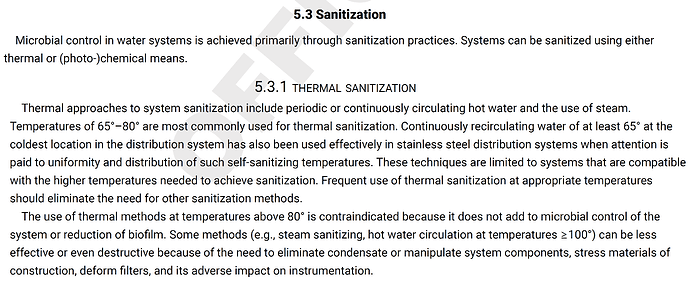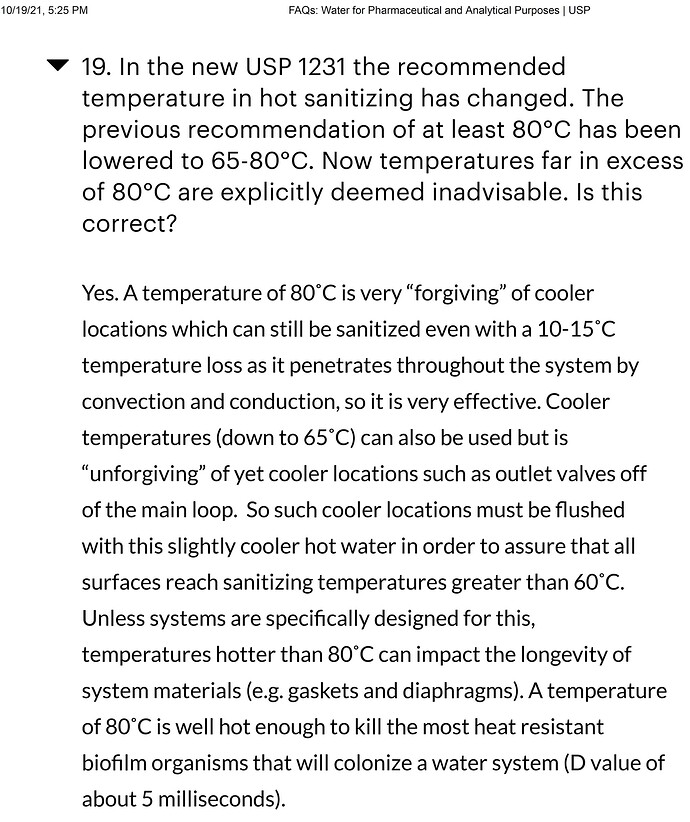Why wfi temperature 80c required
The USP (US Pharmacopeia) used to recommend temperatures of “at least” 80°C for heat sanitization. I
- Heat kills most bacteria at 60°C, and kills essentially all bacterial above 65°C.
- Two common protocols have emerged for sanitizing validated high purity water systems:
- 72°C for 30-60 minutes (bacteria killed in seconds)
- 80°C for 15-30 minutes (bacteria killed in milliseconds)
What is the Optimal Temperature for Sanitizing Water Systems? (70 °C - assuming a suitable plant design.)
Thermal sanitization is still the most common method for keeping pharmaceutical water plants under microbiological control. In fact, for production plants - using ion exchange, osmosis, electrodeionization and ultrafiltration, it is the best method. Many WFI storage systems are operated at continuous high temperatures. Pharmaceutical water systems are often only heated up cyclically to an elevated, germicidal temperature. In each case, the question arises as to the optimal temperature. If the temperature is too high, it can cause material damage, whereas if it is too low, it may not be sufficiently germicidal.
In pharmaceutical plants, a sanitizing temperature of 80 °C is often recommended for ‘historical reasons’. This corresponds to the specification of an earlier edition of the USP (US Pharmacopoeia) "Temperatures of at least 80° are most commonly used ".
However, this temperature can potentially negatively affect the durability of materials such as seals or membranes (as in reverse osmosis). In addition, rouging is to be expected at high temperatures in stainless steel water systems. The hotter the temperature, the more rouging will occur. Overlaying the tank with nitrogen further increases the formation of rouging on SS316L surfaces.
If a temperature of 80 °C can be harmful, the question arises as to whether this temperature is at all reasonable or prescribed in a binding GMP set of rules.
A recent statement on this can be found in USP chapter <1231>. In addition to the temperature and the type of germ, the exposure time is essential for germ killing. The kill rate is a function of temperature, which is indicated by means of D-value. For example, the D-value for most microorganisms at 80 °C is five milliseconds. This means that in 5 milliseconds the initial microbial load is reduced to one tenth. Furthermore, the sanitizing temperature of 80 °C is intended to ensure that the temperature required to kill microorganisms is reached in all parts of a system for a sufficiently long time. However, the USP considers temperatures as low as 65 °C to be sufficient for sanitization. Of course, it must be ensured that the 65 °C is also reached in the so-called ‘cold spots’ of a system. In a ring pipe, the return into the tank can be the coldest spot in the system, but it does not have to be. Adherence to the 3D rule in the design of the system also helps to be able to sanitize safely with temperatures < 80°C.
The USP Chapter 1231 (attached) currently states “Temperatures of 65°-80° are most commonly used for thermal sanitization .”
In the FAQs on pharmaceutical water, the USP refers to 60°C that must be reached on surfaces at the cold spot: "…to assure that all surfaces reach sanitizing temperatures greater than 60°C ." A sensible reduction in the sanitizing temperature can therefore extend the durability of plastic components in particular, reduce rouging and cut operating costs. This is especially true when you consider that there are plants that store their WFI at 85°C in order to have a safety margin from the internally required 80°C at the ‘cold spot’ due to the measurement inaccuracy of the temperature sensor.
So what is the optimal sanitizing temperature? For most generation plants and storage and distribution systems, the optimum is between 60 and 80°C. A temperature of 65 °C has proven to be effective, but with a safety margin it can also be 70 °C - assuming a suitable plant design.
USP Chapter 1231:
USP Chapter 1231 FAQs:

